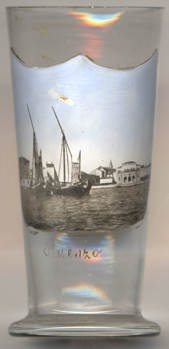

|
| HRVATSKA | CROATIA |
| županija: Istarska |
 Poreč is situated on the western coast of the Istrian penninsula of Croatia. The municipality has a
population of about 16,700 (2011). Its major landmark is the 6th-century Euphrasian Basilica, which was designated a
UNESCO World Heritage Site in 1997.
(see also list of other UNESCO heritage sites depicted on glasses of this collection)
Poreč is situated on the western coast of the Istrian penninsula of Croatia. The municipality has a
population of about 16,700 (2011). Its major landmark is the 6th-century Euphrasian Basilica, which was designated a
UNESCO World Heritage Site in 1997.
(see also list of other UNESCO heritage sites depicted on glasses of this collection)
During the 2nd century BC, a Roman castrum was built on a tiny peninsula where the town centre is now. In the 1st century BC, it officially became a city and was part of the Roman colony of Colonia Iulia Parentium. In the 3rd century the settlement had an organised Christian community with an early-Christian complex of sacral buildings. The earliest basilica dates back to the second half of the 4th century. The floor mosaic from its oratory is still preserved in the garden of the Euphrasian Basilica. With the fall of the Roman Empire in 476, different rulers and powers governed. First, it was held by the Ostrogoths and after 539 was part of the Byzantine Empire. From 788 it was ruled by the Franks. A short independence period followed in the 12th century and later it was ruled by the Patriarchate of Aquileia. In 1267 Parenzo became the first Istrian city that chose to become part of the Republic of Venice, whose rule lasted for more than five centuries. In 1354 the city was destroyed by the Republic of Genova. In 1363 the town was given the city statute. After the fall of the Venetian Republic, Parenzo came under the sovereignty of the Habsburg Monarchy. Between 1805 and 1814, Parenzo was part of the Napoleonic Kingdom of Italy and then of the Illyrian Provinces, nominally part of the First French Empire. After this period it was again annexed by the Habsburgs, with the Monarchy reorganized into the Austrian Empire. In the second half of the 19th century, parenzo slowly became a shipbuilding centre. It also became a popular tourist resort for the Austro-Hungarian aristocracy. After 1918, it became part of the Kingdom of Italy. In 1947, two years after World War II, it was occupied by Yugoslavia and the city name was changed into Poreč.
The  town hall [left, no. 3689: background right] was built in 1909
by the architects Ruggero Berlam und Arduino Berlam aus Trieste.
town hall [left, no. 3689: background right] was built in 1909
by the architects Ruggero Berlam und Arduino Berlam aus Trieste.
[https://en.wikipedia.org/wiki/Poreč, https://de.wikipedia.org/wiki/Poreč]
![[scale]](lineal.jpg)